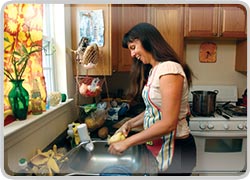 I was born in Belgium and my family is from Verviers, which is very close to where the fry originated. It started in the Meuse Valley—the Meuse is a river in Southeastern Belgium—but the origin of the fry is from 1680, which is before Belgium was even a country. Poor inhabitants of that area used to cook up small fish from the Meuse River, fry them. But when the river froze over, a woman grabbed a potato and cut it into long shapes that resembled the fish and threw them in the fryer. It’s still a Belgian tradition to have these thick fries. This is the Belgian way. Of course, fries have gone all around the world and the French fries tend to be skinnier.
I was born in Belgium and my family is from Verviers, which is very close to where the fry originated. It started in the Meuse Valley—the Meuse is a river in Southeastern Belgium—but the origin of the fry is from 1680, which is before Belgium was even a country. Poor inhabitants of that area used to cook up small fish from the Meuse River, fry them. But when the river froze over, a woman grabbed a potato and cut it into long shapes that resembled the fish and threw them in the fryer. It’s still a Belgian tradition to have these thick fries. This is the Belgian way. Of course, fries have gone all around the world and the French fries tend to be skinnier.
The secret to the Belgian fry—and there really is a difference; in Belgium everyone celebrates how good these fries really are; there are fry stands all over Belgium and you go there; they serve them with all sorts of dipping sauces, which I’ll talk about in a minute—but you fry them twice! The first time on a lower heat, until the fry is barely cooked all the way through, for 5-10 minutes. I don’t have a fry-daddy or a friteuse with a basket inside, which is really what I’d need for this, because it has a temperature gauge, so I’m using my gumbo pot. Let the fries cool completely and then right before serving, you fry them again on a very high temperature for 3-5 minutes until crisp and golden.
God, it’s so loud! I’m imagining what it was like for women to make fries for their families during the war. Belgium was a very bloody battlefield during World War II and potatoes saved the day, yet again. Fish and chips? Total steal! Everything, when it comes down to it, really originates in Belgium. The smurfs are from Belgium, I’d like to point out. Those little adorable blue creatures, called Schtroumphs in French. They originated in a very similar location to where the fry originated. So, yeah, a lot of good things coming out of Belgium. Glad to share.
Let’s discuss the stages of the fry. We’re at stage one: the raw fry. Some of these are better cut than others, but we did find one of the more perfect fries here. And I think we’re ready. I’m now placing the fries in the pot and you’ll hear a change in the sound. Aaah, the fryer is happy; it has its fries. I’m using a safety device between me and the oil. Some people call this a strainer. I like to think of it as a fry safety device. It’s good not to get your skin too close to the hot oil. So, we get it all in, and now I’m going to monitor them. It’s like being a lifeguard. And we’re going to have a sip of beer, which is also a very Belgian thing to do.
I learned how to make fries in Belgium from my friend Louise-Marie and her mom. I never paid attention more than when I was at the fritures themselves, waiting in line for fries, and you just see it happening. Another thing I’ve failed to mention is to salt the fries right away when they come out of the fryer the second time. It’s important not to wait because you want the salt to absorb into the hot oil. Otherwise it falls off. Remember, you want the fries to cool completely before you cook them the second time. You can leave them on the counter or put them in the fridge. I’ve never tried freezing them, but I don’t see why that wouldn’t work. The shock effect of going from cold to hot helps. Another trick for cooking these fries in New Orleans is to turn your AC up really high.
If you were to go to Chez Antoine in Brussels and order fries, you would have your choice of different colored forks—green and pink and blue and white and yellow and orange—so you get your choice of what you’re going to eat your fries with, and you let them know what sauce you want, and the sauce is crucial. A true Belgian fry-eating experience is about a mayonnaise-based sauce. How you make your mayonnaise is going to effect how you enjoy your fry. I learned how to make mayonnaise in Belgium. It’s very simple. You take an egg yolk and a teaspoon of mustard—this is Louise-Marie’s mom—and you slowly pour the oil in while you stir in one direction and it’s important to keep stirring in the same directions because otherwise it might not take, solidify, have the right consistency. Today I’m doing the quick and dirty, which is putting some [store-bought] ketchup and mayonnaise together, and we’re going to call this cocktail sauce.
Now the fries are ready to come out. Feel the fry. It must be cooked almost all the way, just barely cooked! The worst thing in the world would be to bite into a fry that’s not cooked all the way through, but you also don’t want them to fall apart. These look good; these look real good, actually. But this one is mushy and this one is teaching me that I need a friteuse in order to treat people to an even better Belgian perfection.
Fries are like crepes. You can put anything you want on them. I’ve been thinking about a dipping sauce with blue cheese and avocado, but I haven’t tried it yet.
Belgian Fries—a main course!
 |
large russet potatoes (about two per person)
vegetable or peanut oil
salt
ketchup
mayonnaise
1 clove garlic
Peel and wash potatoes. Cut them into half-inch thick fries. Deep-fry in oil for 5-10 minutes until fries are barely cooked. Let fries cool completely. Fry fries again in oil for 3-5 minutes until crisp and golden. Salt fries immediately. Serve hot with dipping sauces of your choice. Helen always serves a “straight mayo.” She also stirs together equal parts mayonnaise and ketchup for cocktail sauce, and minces a clove of garlic and stirs it into mayonnaise in a third bowl for “fake aioli.”




